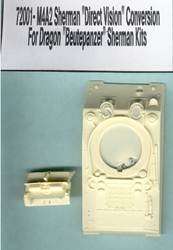|
| www.onthewaymodels.com |
M4A2 Direct Vision Early Hull |
|||
| Kit # 72001 | Review
by Stephen 'Tank Whisperer' Brezinski
- sbrez(at)suscom-maine(dot)net |
||||
|
| www.onthewaymodels.com |
M4A2 Direct Vision Early Hull |
|||
| Kit # 72001 | Review
by Stephen 'Tank Whisperer' Brezinski
- sbrez(at)suscom-maine(dot)net |
||||
 |
| It
makes sense that a nice hull of this early M4A2 tank variant should
drop into my lap just a week after I completed a challenging conversion
of a UM plastic M4 to an M4A2 with direct vision (DV). The description on the label states that it is for the Dragon Beutepanzer Sherman kits. I think this is too limiting for the conversion kit, as the hull should be able to be used with any of DML’s M4A2 and Sherman III lower hulls and low-bustle turret as the VVSS suspension and lower hulls are the same. This upper hull may also be used with DML’s M4 or M4A1 Sherman kits as the suspension is the same though the lower hull’s bottom plate will have different access hatches. My preference is to use this upper hull with the Trumpeter M4 Early kit #7223. This Trumpeter kit comes with an incorrect upper hull glacis but otherwise has good detail so for me makes a good donor kit for parts. The Dragon hulls are just too nice to put in the parts box. There are no written instructions for this conversion kit but it is so basic I do not believe instructions are needed. At left
is the rear engine plate with the characteristic twin exhausts for
the M4A2’s two diesel engines. On the glacis we see the two rounded driver’s hoods with the direct vision visors. These openable visors were found to be weak spots so appliqué armor plates were later fitted over these visors at the factory and in field workshops. Accurate looking weld seams are visible around the hoods and the armor plates. References shows that there could be additional weld seams on the glacis. This early 57 degree glacis was made from one to five smaller flat plates welded around the two hoods so no wonder the cast hull was much less labor to produce. This
kit hull appears to have been manufactured by Baldwin Locomotive Works
based on features like the horseshoe shaped radio pot on the glacis. Building
Tips References
|
| Back to 72 Brigade Kit List | Back to Home Page |
Article Last Updated: 21 January 2013 |